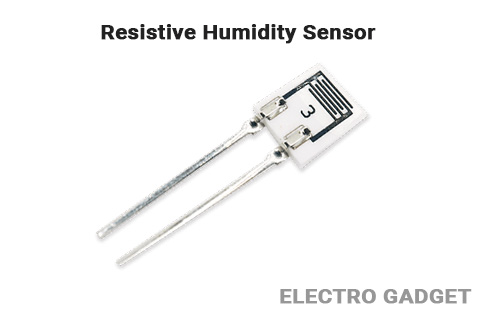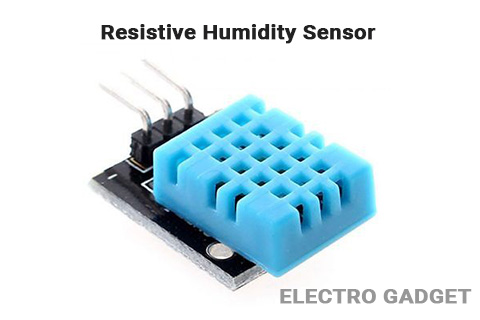Every time, when the rains come down to earth, after that our nearby surroundings feel moist. The rain water appears to have suspended all around. In some advanced ACs, you just need to click some special buttons and after a few minutes, it becomes totally clear. How and why does everything occur? Moisture forms in the air, and for this reason, in our surroundings, we are feeling moist. The Humidity Sensor in your AC system catch up with this moisture and cleans it up totally. Cool yah! Now let’s talk about how this sensor works.
What is Humidity Sensor?
A Humidity Sensor is an electronic device that can detect and measure vaporized water in any substance and converts it into an analogue signal. These sensors are in various sizes and functionality like handheld devices and on the other hand, they can be found in larger embedded systems.
How Many Types of Humidity Sensors
There are basically three different types of humidity sensor is available.
- Capacitive Humidity Sensor
- Resistive Humidity Sensor
- Thermal Humidity Sensor
Capacitive Humidity Sensor

A capacitive humidity sensor measures relative humidity by setting a thin piece of metal oxide between two electrodes. The metal oxide’s electrical limit changes with the air’s relative humidity. Vaporized water can enter this layer and change the capacitance.
The capacitive kind sensors are direct and can measure relative humidity from 5% to 95%. As the sensor utilizes vaporized water from all around, putting the sensor in the way of moving air permits it to react faster. The relative humidity is straightforwardly dependent on the temperature and the sensor has a thermistor utilized for adjustment.
Working Principle of Capacitive Humidity Sensor
A simple capacitive humidity sensor can be made from an air-filled capacitor as the moisture in the atmosphere changes its permittivity. But for practical applications, air as a dielectric is not feasible.
Hence, the gap between these capacitor plates is usually filled with an appropriate dielectric material, whose dielectric constant varies when it is subjected to a change in humidity.
The common method of constructing a capacitive humidity sensor is to use a hygroscopic polymer film as a dielectric and deposit two layers of electrodes on either side.
Another way to use the capacitive humidity sensors is to observe the changes in the frequency of the oscillator constructed using a capacitor with humidity sensitive test subject as a dielectric. This setup is often employed in pharmaceutical products.
The test samples like medical tablets are placed between two plates (which form the capacitor electrodes) to form a capacitor in the LC oscillator circuit. The frequency of the oscillator changes with the humidity surrounding the test sample.
Let us see the construction of a thin thermostat polymer film-based capacitive humidity sensor. It is fabricated on a silicon substrate. On this substrate, two metal electrodes made of either aluminium, platinum or chromium are deposited. The shape of these electrodes is carved out such that, the electrodes form an interdigitated pattern.
On top of this layer, a dielectric layer is deposited. The following image shows a top and cross-section view of the capacitive humidity sensor. Note that two temperature-sensitive resistors are deposited on the same substrate to provide temperature compensation.
Advantages of Capacitive Humidity Sensor
- The output voltage is near linear.
- They provide stable results over long usage.
- It can detect a wide range of RH.
Disadvantages of Capacitive Humidity Sensor
- The distance from the sensor and signalling circuit is very limited.
Application of Capacitive Humidity Sensor
- HVAC Systems
- Weather Stations
- Automobiles
- Food Processing
- Refrigerators, Ovens etc
For further details check out this article Capacitive Humidity Sensor
Resistive Humidity Sensor

A Resistive humidity sensor measures the change in terms of the electrical impedance of a hygroscopic medium such as a conductive polymer, salt, or treated substrate.
Resistive sensors are based on interdigitated winding. After deposition of a hygroscopic polymer coating, their resistance changes inversely with humidity. The impedance change is typically an inverse exponential relationship to humidity.
It is also called an RH sensor.
Working Principle of Resistive RH Sensor
The Resistive RH Sensor is usually made up of materials with relatively low resistivity and this resistivity changes significantly with changes in humidity. The relationship between resistance and humidity is inverse exponential. The low-resistivity material is deposited on top of two electrodes.
The electrodes are placed in an interdigitated pattern to increase the contact area. The resistivity between the electrodes changes when the top layer absorbs water and this change can be measured with the help of a simple electric circuit.
Some of the commonly used materials are salt, specially-treated substrates, solid polyelectrolytes and conductive polymers. Modern Resistive RH Sensors are coated with a ceramic substance to provide extra protection. The electrodes in the sensor are usually made of noble metals like gold, silver or platinum.
Advantages of Resistive RH Sensor
- Low cost
- Small Size
- The distance between the sensor and the signal circuit can be large
- Highly interchangeable as there are no calibration standards
Advantages of Resistive RH Sensor
- Resistive RH Sensors are sensitive to chemical vapours and other contaminants
- The output readings may shift if used with water-soluble products.
Applications of Resistive RH Sensor
Resistive or Electrical Conductive Humidity sensors are low-cost sensors with relatively small sizes. They are often used in several industrial, domestic or residential and commercial applications.
For further details check out this article Resistive Humidity Sensor.
Thermal Humidity Sensor

Thermal humidity sensors are also known as Absolute Humidity (AH) Sensors as they measure the absolute humidity. Thermal humidity sensors measure the thermal conductivity of both dry air as well as air with water vapour. The difference between the individual thermal conductivities can be related to absolute humidity.
Working Principle of Thermal Humidity Sensor
The best component to accomplish a thermal conductivity-based sensor is a thermistor. Hence, two tiny thermistors with negative temperature coefficients are used to form a bridge circuit.
In that, one thermistor is hermetically sealed in a chamber filled with dry Nitrogen while the other is exposed to an open environment through small venting holes. When the circuit is powered on, the resistance of the two thermistors is calculated and the difference between those two values is directly proportional to Absolute Humidity (AH).
Advantages of Thermal Humidity Sensor
- Suitable for high-temperature environments and high-corrosive situations.
- It is very durable
- Higher resolution compared to other types
Disadvantage of Thermal Humidity Sensor
- Exposure to any gas with thermal properties different than Nitrogen might affect the reading measurement.
Applications of Thermal Humidity Sensor
- Drying kilns
- Pharmaceutical plants
- Owens
- Clothes dryers and drying machines
- Food dehydration
Basic Parameters of Humidity Sensor
So once you know all types of humidity sensors and their working principle and applications, now let us talk about some of their parameters.
Accuracy
Every sensor has its own calibration curve, based on a 9-point system. It basically pitches the pros against the cons of the particular sensor.
Linearity
It indicates the voltage deviation from the BFSL value and the measured output voltage value, converted to relative humidity.
Reliability
The measurements often cause the sensor to fall out of sync. However for a sensor to be useful, it has to provide reliable measurements.
Repeatability
The measurements from a sensor, have to be so that they don’t drift apart. Repeatability is the measurement of drift among measurements of a single quantity.
Response Time
Typically, the time taken by a sensor to rise to 66% (rise time) or fall to 33% (fall time) of maximum output voltage, is known as the response time.
Summary
Humidity sensors are sensors that convert the moisture content in the air, gases, bulk materials or soil into an electric output signal.
The demand for humidity sensors with higher accuracies, higher repeatability and long-term stability is growing. Wireless humidity sensors are on the rise for monitoring humidity in greenhouses, industrial applications and even in the residential sector.
For more latest projects about this type of sensor please check out this link Arduino-Based Humidity Sensor Projects
Very helpful article. Humidity sensors are used in many DIY projects..
Every weekend I used to pay a visit to this web
the site, for the reason that I wish for enjoyment,
since this web page conation genuinely fastidious funny material too.
Very nice post. I simply stumbled
upon your weblog and wanted to say
that I’ve truly loved surfing around your blog
posts. In any case I’ll be subscribing in your
feed and I am hoping
you write again soon!